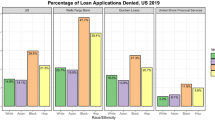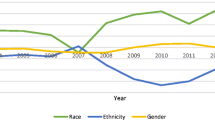Abstract
This study investigates the use of HMDA data for CRA-rated (Community Reinvestment Act) banks to study possible bank loan discrimination against minorities from 2007 to 2016. We examine banks rated Outstanding for compliance with the CRA, which means that regulators believe that these banks are doing an outstanding job at serving low- and moderate-income neighborhoods. We expect that CRA Outstanding rated banks are unlikely to commit taste-based discrimination. We find that these banks have statistical discrimination in loan approvals for Asian, Black, Hispanic, and women borrowers. We also find that these banks have statistical discrimination against white males without co-applicants relative to the omitted group of white males with co-applicants. This result is inconsistent with taste-based discrimination. We conclude that either the models or the HMDA data are ill-suited for studying lending discrimination.
Similar content being viewed by others
Data availability
All the data used in this study are publicly available.
Code availability
Code is available upon request.
Notes
We note that regulators can and do use more sophisticated models with additional data, but models like ours are used as a first step to identify possible discrimination. Journalists and other researchers also use these simplified models in addition to univariate statistics as a first step to investigate possible discrimination.
The CFPB did not open until July of 2011, which is about in the middle of our sample period. However, we view CFPB enforcement actions in consumer lending as a signal of government and regulators desire and efforts to eliminate taste-based lending discrimination.
Since we introduced taste-based discrimination, let us provide some background on Dr. Black as he states that he just follows the data. Dr. Harold Black is Professor Emeritus in Finance at the University of Tennessee. However, the part of Dr. Black’s background that is relevant to a discussion of taste-based discrimination is that Dr. Black graduated from Booker T. Washington High school in Atlanta, GA, and became the first black male freshman to enroll at the University of Georgia in 1962. He graduated from UGA with his BBA in 1966. He received his MA (1968) and PhD (1972) from The Ohio State University.
We note that improved methods through time have often led to no statistical discrimination where it had been found previously (see, for example, Jackson and Lindley (1989)).
For general CRA examination schedules, see the FDIC website at https://www.fdic.gov/news/news/financial/2006/8cep_otherexam.pdf for an example of exam schedules.
We also examine FHA-insured loan data for robustness and find little difference from the main results, so the FHA-insured results are not reported in the interest of brevity.
We use the HMDA data as reported to classify applicants based on self-reported ethnicity and race. For applicants choosing Hispanic as their ethnicity, they are coded as being Hispanic and their choice of race is not used. For other non-Hispanic applicants, their choice of race is used to create these indicator variables.
We also estimate Variance Inflation Factors (VIF) in the OLS models to see if there are problems with the estimates being biased due to multi-collinearity. Even though some of the correlations for independent variables approach 40%, the VIFs do not indicate severe collinearity problems.
The Fair Housing Act prohibits discrimination in housing based on: race, religion, gender, national origin, familial status, or disability.
We also have 37 bank observations in the sample of 4-rated banks, but these banks make few if any conventional mortgage loans and were therefore removed. If included, results are the same, so they are omitted in the analysis.
The lender could be discriminating against the co-applicant based on race. The lender knows the co-applicant’s race while making the loan. The co-applicant race is also indicated in the HMDA data. We re-estimate the regressions with an indicator variable that was coded zero if the borrower and co-applicant were the same race, and one if they were different. OLS parameter estimates for the different race co-applicant indicator variable had a p-value of 0.37, and was also insignificant in the logistic regression. Other primary results were unchanged. The data across the whole sample had different races listed between applicant and co-applicant less than one percent of the time for Hispanic applicants, 3.7% of the time for Asian applicants, 4.1% of the time for Black applicants, and 1.9% of the time for White applicants. We thank the referee for pointing out this possibility.
References
Bhutta, N. (2011). The community reinvestment act and mortgage lending to lower income borrowers and neighborhoods. Journal of Law and Economics, 54(4), 953–983.
Black, H. A. (1999). Is there discrimination in mortgage lending? What does the research tell us? Review of Black Political Economy, 27(1), 23–30.
Black, H. A., Collins, M. C., & Cyree, K. B. (1997). Do black-owned banks discriminate? Journal of Financial Services Research, 11(1 and 2), 189–204.
Black, H. A., Robinson, B. L., Schlottmann, A. M., & Schweitzer, R. L. (2003). Is race an important factor in bank-customer preferences? The case of mortgage lending. Journal of Real Estate Finance and Economics, 26(1), 5–26.
Black, H. A., Schweitzer, R. L., & Mandell, L. (1978). Discrimination in mortgage lending. The American Economic Review, 68(2), 186–191.
Block, W., Snow, N., & Stringham, E. (2008). Banks, insurance companies, and discrimination. Business and Society Review, 113(3), 403–419.
Bostic, R. W., & Robinson, B. L. (2003). Do CRA agreements influence lending patterns? Real Estate Economics, 31(1), 23–51.
Bostic, R. W., & Robinson, B. L. (2004). The impact of CRA agreements on community banks. Journal of Banking and Finance, 28(12), 3069–3095.
Campbell, R., Roberts, B., & Rogers, K. (2008). An evaluation of lender redlining in the allocation of unsecured consumer credit in the US. Urban Studies, 45(5&6), 1243–1254.
Cavalluzzo, K. S., & Cavalluzzo, L. C. (1998). Market structure and discrimination: The case of small businesses. Journal of Money, Credit and Banking, 30(4), 771–792.
Cavalluzzo, K. S., Cavalluzzo, L. C., & Wolken, J. D. (2002). Competition, small business financing, and discrimination: Evidence from a new survey. Journal of Business, 75(4), 641–679.
Cheng, S. (2015). Potential lending discrimination? Insights from small business financing and new venture survival. Journal of Small Business Management, 53(4), 905–923. https://doi.org/10.1111/jsbm.12112
Delis, M. D., & Papadopoulos, P. (2019). Mortgage lending discrimination across the US: New methodology and new evidence. Journal of Financial Services Research, 56, 341–368.
Evanoff, D. D., & Segal, L. M. (1996). CRA and fair lending regulations: Resulting trends in mortgage lending. FRB-Chicago Economic Perspectives, 20, 19–46.
Gilkeson, J. H., Winters, D. B., & Dwyer, P. D. (2003). How banks can self-monitor their lending to comply with the Equal Credit Opportunity Act. FRB-St Louis Economic Review, 85, 7–22.
Han, S. (2011). Creditor learning and discrimination in lending. Journal of Financial Services Research, 40(1), 1–27.
Hein, S., Koch, T., & MacDonald, S. (2005). What makes community banks Unique? FRB-Atlanta Economic Review, First Quarter, 90(1), 15–36.
Horne, D. (1997). Mortgage lending, race, and model specification. Journal of Financial Services Research, 11, 43–68.
Hylton, K. N., & Rougeau, V. D. (1999). The Community Reinvestment Act: Questionable premises and perverse incentives. Annual Review of Banking Law, 18, 163–196.
Jackson, J. D., & Lindley, J. T. (1989). Measuring the extent of wage discrimination: A statistical test and a caveat. Applied Economics, 21, 515–540.
Kau, J. B., Keenan, D. C., & Munneke, H. J. (2012). Racial discrimination and mortgage lending. Journal of Real Estate Finance and Economics, 45, 289–304.
Kwast, M. & Black, H. (1983). An analysis of the behavior of mature black-owned commercial banks. Journal of Economics and Business, 35(1), 41–54.
Munnell, A. H., Tootell, G. M. B., Browne, L. E., & McEneaney, J. (1992). Mortgage Lending in Boston: Interpreting HMDA Data. Federal Reserve Bank of Boston, Working Paper, pp. 92–97.
Munnell, A. H., Tootell, G. M. B., Browne, L. E., & McEneaney, J. (1996). Mortgage lending in Boston: Interpreting HMDA data. The American Economic Review, 86(1), 25–53.
Ross, S. L., & Tootell, G. M. B. (2004). Redlining, the Community Reinvestment Act, and private mortgage insurance. Urban Economics, 55, 278–297.
Schill, M. H., & Wachter, S. M. (1993). A tale of two cities: Racial and ethnic geographic disparities in home mortgage lending in Boston and Philadelphia. Journal of Housing Research, 4(2), 245–276.
Smith, B. C., & Daniels, K. N. (2018). Unintended consequences for risk based pricing: Racial differences in mortgage costs. Journal of Financial Services Research, 54, 323–343.
Tootell, G. M. B. (1996). Redlining in Boston: Do mortgage lenders discriminate against neighborhoods? Quarterly Journal of Economics, 111(4), 1049–1079.
Funding
This research did not receive any specific grant from funding agencies in the public, commercial, or not-for-profit sectors.
Author information
Authors and Affiliations
Contributions
The authors contributed equally to this study.
Corresponding author
Ethics declarations
Conflict of interest
The authors do not have any conflicts of interest.
Additional information
Publisher's Note
Springer Nature remains neutral with regard to jurisdictional claims in published maps and institutional affiliations.
Rights and permissions
Springer Nature or its licensor (e.g. a society or other partner) holds exclusive rights to this article under a publishing agreement with the author(s) or other rightsholder(s); author self-archiving of the accepted manuscript version of this article is solely governed by the terms of such publishing agreement and applicable law.
About this article
Cite this article
Cyree, K.B., Winters, D.B. Investigating bank lending discrimination in the US using CRA-rated banks’ HMDA loan data. Public Choice 197, 371–395 (2023). https://doi.org/10.1007/s11127-023-01078-5
Received:
Accepted:
Published:
Issue Date:
DOI: https://doi.org/10.1007/s11127-023-01078-5




